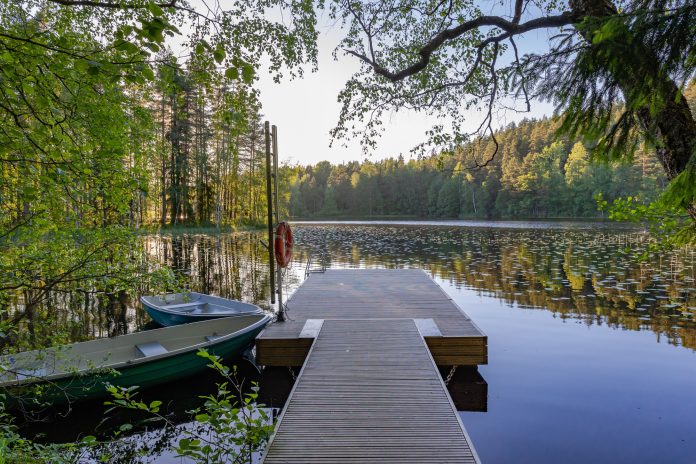When enhancing the allure of your pond, a well-designed dock can be a game-changer. A carefully crafted dock provides easy access for fishing, swimming, boating, wildlife viewing, and simply sitting and relaxing by the water. But, like other things, designing a dock for your pond requires careful planning and consideration.
Whether you’re a nature enthusiast, an avid angler, or simply looking to create a serene retreat, a thoughtfully designed dock can make all the difference. That said, this article shows the key elements and steps you’ll need to consider when designing the perfect dock for your pond that can blend seamlessly into your pondscape.
- Assess the Pond Environment
First, you need to assess the pond’s environment. Understanding the unique characteristics of your pond can help you choose a dock that seamlessly integrates with its surroundings. So, take note of the water depth and shoreline characteristics of the pond.
You must also identify any potential obstacles or hazards in the pond that may impact the dock’s placement or design. Rocks, trees, underwater vegetation, or uneven terrain can pose challenges and restrict the available space for the dock. Overall, by assessing the pond’s environment first, it’ll be easier for you to explore a gallery of docks from a reputable dealer and choose the best kind of dock suitable for your pond.
- Determine the Dock’s Purpose
Next, determine the primary purpose of your dock. Are you looking for a dock primarily for recreational activities, such as fishing or sunbathing? Or do you need a functional space for launching boats and other watercraft? Understanding the dock’s purpose will help inform its design and layout.
- Choose the Right Materials
Selecting the right materials for your dock is crucial for its durability and longevity. Since the dock will be exposed to water and various weather conditions, durability is crucial. Look for dock materials resistant to rot, corrosion, and damage caused by prolonged moisture exposure. Popular options for dock construction include pressure-treated wood, composite decking, and aluminum.
Furthermore, take your budget into account when selecting materials for your dock. Pressure-treated wood tends to be more affordable, while composite decking and aluminum options may come at a higher price point. However, considering the long-term maintenance needs of different materials can help you make a cost-effective choice in the long run.
- Consider the Dock’s Size and Layout
The size and layout of your dock will depend on various factors like available space, budget, available space, and intended use. Measure the shoreline area where you plan to install the dock and take into account any local regulations or permits required. Aim for a size that offers sufficient space for your desired activities without overwhelming the pond’s visual appeal. Generally, a smaller, intimate pond may benefit from a cozy square or rectangular dock, while a larger, more open space could accommodate a sprawling T or L-shaped design for panoramic views.
- Incorporate Safety Features
Safety should be a top priority when designing a dock. Ensure the dock has sturdy railings or barriers to prevent accidents, particularly if you have children or pets. Install non-slip decking material to reduce the risk of slips and falls.
If your pond experiences strong currents or fluctuating water levels, consider adding a ramp or stairs for easy access and exit. Incorporating lighting along the edges can also extend the usability of your dock into the evening, creating a magical ambiance while enhancing safety.
- Enhance the Aesthetics
While functionality is crucial, the aesthetics of your pond dock should not be overlooked. Look for design elements that harmonize with the surrounding landscape. Consider adding features such as built-in benches, flower boxes, pond plants, or solar-powered lighting to enhance the ambiance and usability of the dock.
- Seek Professional Assistance
If you are unsure about the technical aspects of designing your pond dock, it is wise to seek professional assistance. Consulting with a dock builder or a landscape architect specializing in water features can ensure that your design is structurally sound and meets all safety requirements.
- Install the Dock
Once you have finalized the design and gathered the necessary materials, it’s time to install your dock. Follow the manufacturer’s instructions carefully or hire a professional for a seamless installation. Double-check that the dock is level and secure before using it, and regularly inspect and maintain it to extend its lifespan.
- Follow Regular Maintenance for Longevity
To preserve the beauty and functionality of your dock, regular maintenance is key. Inspect for wear and tear, treat or replace damaged components promptly, and protect against weathering with sealants or coatings. A well-maintained dock not only looks better but also extends its lifespan.
Wrap Up
Designing a perfect dock for your pond requires attention to detail, careful planning, and consideration of safety and aesthetics. With these steps, you can now create a functional and visually appealing dock. Remember to seek professional assistance if necessary and perform regular maintenance to ensure its longevity. Enjoy your new dock and the enhanced pond experience it brings!
















